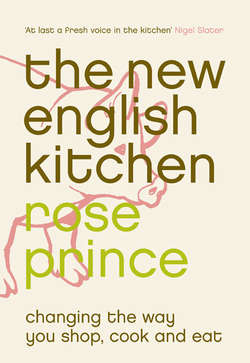Читать книгу The New English Kitchen: Changing the Way You Shop, Cook and Eat - Rose Prince - Страница 9
the giant bread machine
Оглавление‘All our bakers are master bakers,’ the factory manager told me. At that moment a master baker, dressed in regulation cover-up clothing, pushed a button and the bread production line swung into action.
Real master bakers are trained to use their hands to judge the texture of the dough, feeling its elasticity and warmth. They learn their trade in high-street bakeries or medium-sized bread wholesalers, where the bread is made at night. After leaving school, I worked as a shop assistant in a traditional bakery for nearly two years. The baker arrived at one in the morning to start the baking and clocked off at 8 a.m., half an hour after we turned the door sign to read ‘open’. The hardship of beginning work at 7 a.m. was tempered by that gorgeous smell of bread emerging from the oven. As I walked to the bakery in the dark early morning, the aroma grew gradually more powerful until I was close enough to see a spectre of steam puffing out of the basement. The baker, Steve, who had spent time ‘inside’ after a fight, controlled his aggression with an interest in martial arts. But he also loved to bake. He liked the science and enjoyed using his skill – judging the readiness of the dough at every stage, shaping it by hand, and baking it in a century-old brick oven. He even liked to be up at night working while everyone else slept. His hours were strictly controlled by his trade union, in spite of his lonely job. Any slight alteration to the weekly timetable was subject to intense negotiation: well-muscled Steve versus a skinny shop manager, hell bent on not provoking the baker to lose his temper.
In the Midlands factory I visited many years later, the bakers use their hands only to push buttons during their eight-hour shift. This bread is made via the Chorleywood Process, the revolutionary high-speed mechanical baking system invented in 1961. The factory never rests, baking around the clock. It takes just one and three-quarter hours for a loaf to make its journey along the production line, helped by extra yeast and water and high-speed mixers. It is necessary to add flour ‘improvers’, usually in the form of soya flour, to ensure that the bread will literally rise to the occasion in such an artificially short space of time. Enzyme processing aids, softening agents, sugars, fats and preservatives are also sometimes added. These ingredients combine to speed up the natural breadmaking process, resulting in a soft, sweetish loaf with a long shelf life, which fits neatly into the modern maxim that shopping should happen just once a week.
And where do you, the consumer, fit in? The bread factories would say that all this is done for your benefit. This is the bread you want, and indeed for many, soft, sweet bread is easy to like; children in particular are swiftly seduced.
The high-tech mechanisation of bread comes at the cost of its integrity, however. Compare factory-produced bread to Italian dried durum wheat pasta, most of which is now made speedily in giant factories. The mixing is done high in their ceilings, the dough passes through giant tubes, is pressed through the various dies that make the shapes and then travels into vast drying machines that imitate the Neapolitan sun and sea breezes. But it still contains just flour and water. Pasta is perfect for mechanisation – the food itself never loses its integrity. Bread, on the other hand, needs a whole lot of help by way of additives if it is to survive the Chorleywood palaver.
